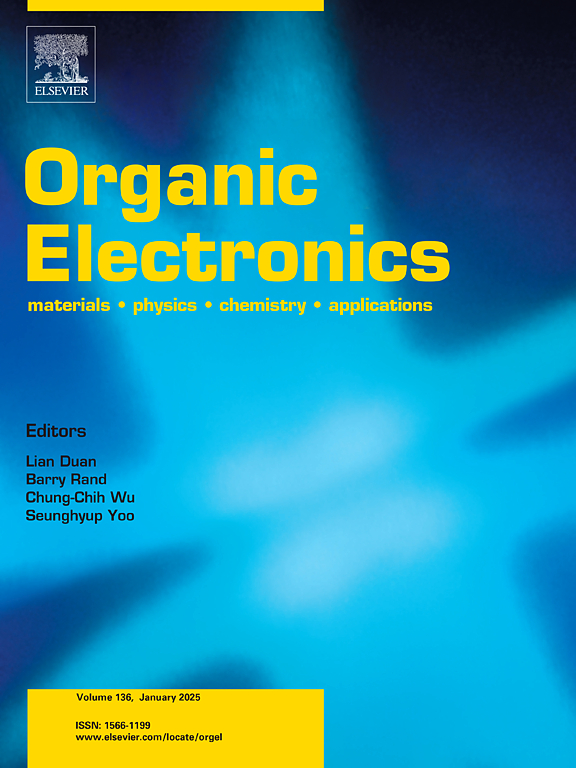Enhancing performance of a photomultiplication-based broadband photodetector with porphyrin MOF-ZnO nanocomposite
IF 2.7
4区 工程技术
Q3 MATERIALS SCIENCE, MULTIDISCIPLINARY
引用次数: 0
Abstract
In this work, a nanocomposite using ZnTCPP MOF and ZnO nanoparticles is synthesized. A broadband photodetector is optimized using this nanocomposite to enhance the performance of a photomultiplication-based organic photodetector. Various weight percentages (w/w%) of ZnO were incorporated in the ZnTCPP metal-organic framework precursor during synthesis, and material parameters were analyzed via structural and chemical analysis methods. These nanocomposites were incorporated in the P3HT:PCBM matrix in a 1:1:0.5 wt ratio, and photodetectors were fabricated with an inverted structure (ITO/TiO2/Active Layer/Al). A reference device with P3HT:PCBM and ZnO nanoparticles is fabricated and compared. Photomultiplication is observed in all the devices, with the devices with nanocomposite showing enhanced quantum efficiency and responsivity. The best-performing ZnTCPP@ZnO-based device reported the highest EQE of 10827 % at 510 nm for a given bias of −5 V. Photomultiplication is attributed to the trap states created due to the TiO2/active layer interface and the presence of ZnO in the active material. ZnO acts as a hole-blocking component, giving rise to charge accumulation and, subsequently, tunneling electrons. These devices have shown high responsivity (44.53 A/W), small rise time/fall time (61.7 ms/107.6 ms), and high detectivity (7.2 × 1011 Jones) at a given bias voltage of −5 V.

卟啉MOF-ZnO纳米复合材料增强光电倍增宽带光电探测器的性能
本文合成了一种由ZnTCPP MOF和ZnO纳米粒子组成的纳米复合材料。利用这种纳米复合材料优化了宽带光电探测器,以提高基于光电倍增的有机光电探测器的性能。在ZnTCPP金属有机骨架前驱体中加入不同重量百分比(w/w%)的ZnO,并通过结构和化学分析方法对材料参数进行了分析。将这些纳米复合材料以1:1:0.5 wt的比例掺入P3HT:PCBM基体中,制备出具有倒置结构(ITO/TiO2/Active Layer/Al)的光电探测器。制备了P3HT:PCBM和ZnO纳米颗粒的参比器件,并进行了比较。在所有器件中都观察到光电倍增,纳米复合材料器件显示出增强的量子效率和响应性。性能最好的ZnTCPP@ZnO-based器件在−5 V的给定偏置下,在510 nm处EQE高达10827%。光电倍增归因于由于TiO2/活性层界面和活性材料中ZnO的存在而产生的陷阱状态。氧化锌作为一个空穴阻断成分,引起电荷积累,随后,隧穿电子。这些器件在给定的- 5 V偏置电压下具有高响应性(44.53 A/W),小上升/下降时间(61.7 ms/107.6 ms)和高探测性(7.2 × 1011 Jones)。
本文章由计算机程序翻译,如有差异,请以英文原文为准。
求助全文
约1分钟内获得全文
求助全文
来源期刊

Organic Electronics
工程技术-材料科学:综合
CiteScore
6.60
自引率
6.20%
发文量
238
审稿时长
44 days
期刊介绍:
Organic Electronics is a journal whose primary interdisciplinary focus is on materials and phenomena related to organic devices such as light emitting diodes, thin film transistors, photovoltaic cells, sensors, memories, etc.
Papers suitable for publication in this journal cover such topics as photoconductive and electronic properties of organic materials, thin film structures and characterization in the context of organic devices, charge and exciton transport, organic electronic and optoelectronic devices.
 求助内容:
求助内容: 应助结果提醒方式:
应助结果提醒方式:


